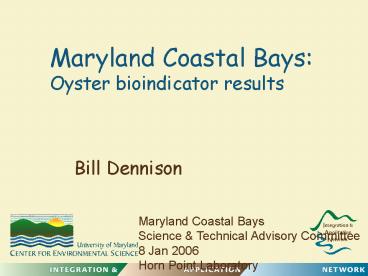Maryland Coastal Bays: Oyster bioindicator results - PowerPoint PPT Presentation
1 / 12
Title: Maryland Coastal Bays: Oyster bioindicator results
1
Maryland Coastal BaysOyster bioindicator
results
Bill Dennison
Maryland Coastal Bays Science Technical
Advisory Committee 8 Jan 2006 Horn Point
Laboratory
2
2004 study identified regions of concern
Regions studied intensively during 2006 study
3
Sampling sites for 2006 study
- Deployed macroalgae for 4 days in May and July
- Deployed oysters from May until July
- 100 sites total
4
May sampling after a long dry spell contrasted
July sampling after heavy rain
5
St Martins River is a mini estuary, with a
flushing gradient
May, 2006
July, 2006
6
Johnsons Bay shows localized freshwater inflows
following rains
May, 2006
July, 2006
7
Warm water temperatures in areas of extensive
seagrass growth are of concern
May, 2006
July, 2006
Temperatures above 30 C potentially threaten
seagrass survival
8
Johnsons Bay and Public Landing both show
localized nitrogen inputs
May, 2006
July, 2006
TN threshold for seagrass survival 46 mM (0.65
mg L-1)
9
Johnsons Bay and Public Landing both show
localized phosphorus inputs
May, 2006
July, 2006
TP threshold for seagrass survival 1.2 mM
(0.037 mg L-1)
10
Gracilaria d15N show patterns at the regional
scale during low water inflow
May, 2006
July, 2006
7.40 (0.09)
6.66 (0.32)
6.78 (0.20)
6.28 (0.28)
6.24 (0.39)
7.60 (0.52)
6.98 (0.24)
6.84 (0.19)
Initial 5.21 (0.11)
Initial 9.48 (1.09)
11
Oyster tissues show regional patterns as well as
small scale patterns within sampling regions
higher resolution due to longer integration
period
May - July
12
Regional differences in water quality are
apparent during dry periods but less so after
heavy rainfall often below threshold values
for seagrass
May
June precipitation
July































